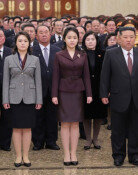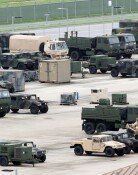Currency Rate War Continued to Defend 1,000 Won Level
Currency Rate War Continued to Defend 1,000 Won Level
Posted March. 11, 2005 22:46,
The battle continued on Friday in foreign exchange markets in Seoul to defend the currency exchange rate of 1,000 won against the U.S. dollar.
The won decreased to the 900 won level at some point during the day for the second day in a row, but the government intervened to maintain the rate to float above the 1,000 won level. The won-dollar rate closed at 1000.3 won on Friday, unchanged from Thursday. Analysts predict that fluctuation around the 1,000 won-level will continue for the moment.
1,000 Won Mark Threatened Again-
Starting at 1,000.1 won, the rate immediately plunged to 999.3 won, recording a three-digit level for the third time this year, following February 23 (998.1 won) and March 10 (989.0 won). The government`s timely intervention moved the rate back to 1002.4 won.
The won-dollar exchange rate showed heavy fluctuation since then as exporters rushed to cash in their dollar payments, moving the rate around the 1,000 won mark.
Does the Government Have Resources to Continue the Currency War?-
After spending $4 billion (4 trillion won) yesterday, the government continued its strong intervention on Friday, buying dollars every time the 1,000 won level was threatened, showing a strong commitment to defend the four-digit currency rate.
The problem, however, is that the government is running out of available resources.
The total volume of currency stabilization bonds the government is eligible to issue for 2005 tops out at 21.9 trillion won.
The government issued seven trillion won from January through February, with two trillion spent for redemption and most of its remaining five trillion was used on Thursday to keep the won-dollar afloat.
The government has the option to use its issuing power to buy additional dollars, which also has its own limitations. In order for the government to redeem the money from the market, it should issue currency stabilization bonds, too many of which were already on the market.
The total amount of outstanding currency stabilization bonds as of the end of January was 144.17 trillion won, a 37 percent increase from the end of 2003`s 105.5 trillion won. The government has already engaged in a vicious cycle of issuing additional bonds just to pay interest.
Using currency issuing power does not mean the actual issuance of new bills; rather, it refers to monetary transactions between the Bank of Korea and commercial banks.
What is More Important, Currency or Interest Rates?-
The government seems committed to keeping the exchange rate intact in order to maintain the nation`s competitiveness on exports. But the dilemma is that such measures could affect low interest rate conditions, which are vital to move the local economy back on track.
Issuing treasury bonds or currency stabilization bonds to defend the currency would increase bond supply, which in turn leads to the rise of the bonds interest rate. This makes the government hesitate on using its issuing power.
High ranking officials in the Ministry of Finance and Economy, known to be cautious in expressing their own opinion, seemed to agree that maintaining a low interest rate is a more important priority.
Chin Dong-soo, deputy minister for international affairs at the Ministry of Finance and Economy said on Thursday, "The government is not currently considering the additional issuance of treasury bonds to defend the foreign exchange market," denying speculation.
Bahk Byong-won, assistant minister of finance and economy said, "I am not supposed to explain the government`s detailed foreign exchange policy or the government`s financial leeway, but its current policy basis of minimizing additional issuance of treasury bonds will not change."
Kyung-Joon Chung Chi-Young Shin news91@donga.com higgledy@donga.com




![전기매트 틀고 자면 몸에 전자파 쌓인다?” 직접 측정해보니 [알쓸톡]](https://dimg.donga.com/c/138/175/90/1/wps/NEWS/IMAGE/2026/01/02/133079758.3.jpg)

![금수산 참배 사진, 김주애의 위치가 말하려는 것[청계천 옆 사진관]](https://dimg.donga.com/c/138/175/90/1/wps/NEWS/IMAGE/2026/01/02/133079009.1.jpg)
